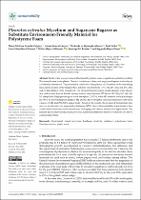| dc.contributor.author | Aranda-Calipuy, Maria Melissa | |
| dc.contributor.author | Roncal-Lázaro, Alexia | |
| dc.contributor.author | Quezada-Alvarez, Medardo A. | |
| dc.contributor.author | Siche, Raúl | |
| dc.contributor.author | Cabanillas-Chirinos, Luis | |
| dc.contributor.author | Rojas-Villacorta, Walter | |
| dc.contributor.author | Benites, Santiago M. | |
| dc.contributor.author | Rojas-Flores, Segundo | |
| dc.date.accessioned | 2023-11-02T15:14:16Z | |
| dc.date.available | 2023-11-02T15:14:16Z | |
| dc.date.issued | 2023-06-06 | |
| dc.identifier.uri | https://hdl.handle.net/20.500.13067/2742 | |
| dc.description.abstract | Biodiversity in ecosystems is threatened by plastic waste, a significant pollution problem. The research aims to use plastic, Pleorotus ostreatus mycelium, and sugarcane bagasse to develop an eco-friendly biomaterial. The preparation consisted of three phases: (1) Treatment of the underlying layer, (2) inoculation of the fungus (three different concentrations: 15%, M1; 20%, M2; and 25%, M3), and (3) dehydration of the biomaterial. The physical characterization results (density, water absorption, and texture) showed that the average density varies between 127.86 and 131.19 kg/m3; also, the M1 sample had a high percentage of water absorption (23.55%), while M2 obtained lower percentages (11.79%). In the bending test, samples M2 and M3 showed higher structural resistance with stress values of 0.682 and 0.68 MPa, respectively. Based on the results, the produced biomaterials may serve as an alternative to expanded polystyrene (EPS). Due to their moldable characteristics, they can be used in non-structural construction, packaging, and various architectural applications. The research provided promising results; however, additional parameters must be evaluated to be able to commercialize them. | es_PE |
| dc.format | application/pdf | es_PE |
| dc.language.iso | eng | es_PE |
| dc.publisher | MDPI | es_PE |
| dc.rights | info:eu-repo/semantics/openAccess | es_PE |
| dc.rights.uri | https://creativecommons.org/licenses/by/4.0/ | es_PE |
| dc.subject | Biomaterial | es_PE |
| dc.subject | Fungal mycelium | es_PE |
| dc.subject | Hardness | es_PE |
| dc.subject | Elasticity | es_PE |
| dc.subject | Resilience | es_PE |
| dc.subject | Polystyrene foam | es_PE |
| dc.subject | Pleurotus ostreatus | es_PE |
| dc.subject | Plastic waste | es_PE |
| dc.title | Pleurotus ostreatus Mycelium and Sugarcane Bagasse as Substitute Environment-Friendly Material for Polystyrene Foam | es_PE |
| dc.type | info:eu-repo/semantics/article | es_PE |
| dc.identifier.journal | Sustainability | es_PE |
| dc.identifier.doi | https://doi.org/10.3390/su15129157 | |
| dc.subject.ocde | https://purl.org/pe-repo/ocde/ford#2.07.00 | es_PE |
| dc.source.volume | 15 | es_PE |
| dc.source.issue | 2023 | es_PE |
| dc.source.beginpage | 1 | es_PE |
| dc.source.endpage | 16 | es_PE |


